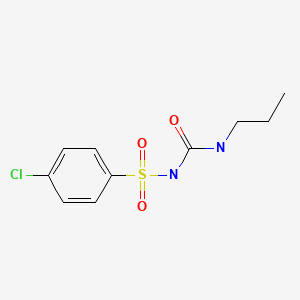Attribution Statement: LactMed is a registered trademark of the U.S. Department of Health and Human Services.
NCBI Bookshelf. A service of the National Library of Medicine, National Institutes of Health.
Drugs and Lactation Database (LactMed®) [Internet]. Bethesda (MD): National Institute of Child Health and Human Development; 2006-.
CASRN: 94-20-2

Drug Levels and Effects
Summary of Use during Lactation
Chlorpropamide is no longer marketed in the United States. Limited data indicate that amounts of chlorpropamide in breastmilk are unlikely to affect a breastfed infant. Short-acting drugs are generally preferred while breastfeeding a neonate to avoid drug accumulation. Monitor breastfed infants for signs of hypoglycemia such as jitteriness, excessive sleepiness, poor feeding, seizures cyanosis, apnea, or hypothermia. If there is concern, monitoring of the breastfed infant's blood glucose is advisable during maternal therapy with hypoglycemic agents.[1,2]
Drug Levels
Maternal Levels. No studies on the excretion of chlorpropamide into breastmilk have been published. The manufacturer states that a level of 5 mg/L was found in breastmilk 5 hours after a 500 mg dose; however, no study details were given.[1,3]
Infant Levels. Relevant published information was not found as of the revision date.
Effects in Breastfed Infants
Relevant published information was not found as of the revision date.
Effects on Lactation and Breastmilk
Relevant published information was not found as of the revision date.
References
- 1.
- Everett JA. Use of oral antidiabetic agents during breastfeeding. J Hum Lact 1997;13:319-21. [PubMed: 9429368]
- 2.
- Berlin CM, Briggs GG. Drugs and chemicals in human milk. Semin Fetal Neonatal Med 2005;10:149-59. [PubMed: 15701580]
- 3.
- Briggs GG, Freeman RK, Towers CV, Forinash AB. Drugs in pregnancy and lactation, 11th ed. Philadelphia. Wolters Kluwer. 2017.
Substance Identification
Substance Name
Chlorpropamide
CAS Registry Number
94-20-2
Drug Class
Breast Feeding
Lactation
Milk, Human
Hypoglycemic Agents
Sulfonylurea Compounds
Disclaimer: Information presented in this database is not meant as a substitute for professional judgment. You should consult your healthcare provider for breastfeeding advice related to your particular situation. The U.S. government does not warrant or assume any liability or responsibility for the accuracy or completeness of the information on this Site.
- User and Medical Advice Disclaimer
- Drugs and Lactation Database (LactMed) - Record Format
- LactMed - Database Creation and Peer Review Process
- Fact Sheet. Drugs and Lactation Database (LactMed)
- Drugs and Lactation Database (LactMed) - Glossary
- LactMed Selected References
- Drugs and Lactation Database (LactMed) - About Dietary Supplements
- Breastfeeding Links
- PubChem SubstanceRelated PubChem Substances
- PubMedLinks to PubMed
- Review Acetohexamide.[Drugs and Lactation Database (...]Review Acetohexamide.. Drugs and Lactation Database (LactMed®). 2006
- Review Tolazamide.[Drugs and Lactation Database (...]Review Tolazamide.. Drugs and Lactation Database (LactMed®). 2006
- Review Glipizide.[Drugs and Lactation Database (...]Review Glipizide.. Drugs and Lactation Database (LactMed®). 2006
- Review Glimepiride.[Drugs and Lactation Database (...]Review Glimepiride.. Drugs and Lactation Database (LactMed®). 2006
- Review Tolbutamide.[Drugs and Lactation Database (...]Review Tolbutamide.. Drugs and Lactation Database (LactMed®). 2006
- Chlorpropamide - Drugs and Lactation Database (LactMed®)Chlorpropamide - Drugs and Lactation Database (LactMed®)
Your browsing activity is empty.
Activity recording is turned off.
See more...
